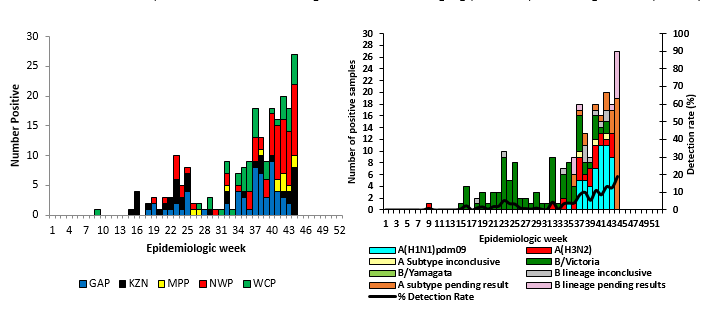A steady increase in the number of influenza cases from week 34 (week starting 23 August 2021) with a sharp increase in week 44 (week starting 1 November 2021) has been reported from the influenza-like illness (ILI) and pneumonia (hospitalised cases) surveillance sentinel sites. In addition, private laboratories have reported an increase in influenza case detections and the National Institute for Communicable Diseases (NICD), a division of the National Health Laboratory Service, has received reports of clusters of influenza cases in schools and workplaces.
Influenza A(H3N2), influenza A(H1N1)pdm09 and influenza B are seasonal influenza virus strains that are common in human populations. Influenza A(H1N1)pdm09, which is sometimes incorrectly referred to as “swine flu”, has been one of the circulating seasonal influenza strains following its emergence in 2009. The term “swine flu” should not be used as it causes unnecessary panic. The clinical course of infection with this influenza strain and clinical management is similar to that of other influenza strains.
As of week 44 of 2021 (week ending 7 November 2021), the total number of influenza cases detected by the syndromic sentinel surveillance programmes conducted by the NICD has increased from 68 in week 34 to 226. The increase in case numbers has been identified in all five (5) provinces where surveillance is conducted. To date, the most commonly detected subtype and lineage is influenza B Victoria (87/226, 38.5%) followed by influenza A (H1N1)pdm09 (53/226, 23.5%) and influenza A (H3N2) (24/226, 10.6%) (Figure 1). Even though the detection rates for influenza in our surveillance programme exceed previous seasonal thresholds, absolute numbers remain relatively low compared to previous years, possibly as a result of reduced health-seeking behaviour following the SARS-CoV-2 pandemic.
“Although the majority of people with influenza will present with mild illness, influenza may cause severe illness, which may require hospitalisation or cause death, especially in individuals who are at risk of getting severe influenza complications,” comments Dr Sibongile Walaza, Medical Epidemiologist at the Centre for Respiratory Diseases and Meningitis (CRDM) at the NICD. Groups at an increased risk of severe complications of influenza include, pregnant women; HIV-infected individuals; those with chronic illnesses or conditions like diabetes, lung disease, tuberculosis, heart disease, renal disease and obesity; the elderly (65 years and older) and children under the age of two years. These groups should be encouraged to seek medical help early.
“The increase in influenza in the summer, which is not the typical time for the influenza season, is likely the result of relaxation of non-pharmaceutical interventions to control COVID-19, combined with an immunity gap due to influenza not circulating for two years (2020 and 2021) in South Africa (as a result of these interventions),” adds Prof Cheryl Cohen, Head of the CRDM. She stresses that the influenza vaccine remains the primary means for preventing seasonal influenza infection and should ideally be administered before the influenza season from March to April.
Currently, because of recent reductions in transmission, influenza may not circulate in the traditional seasonal period. It is never too late to vaccinate during periods when influenza is circulating, especially for individuals with underlying conditions which put them at increased risk of severe influenza illness or complications.
To prevent contracting or spreading flu avoid close contact with sick people, stay home when you are sick, cover your mouth and nose when coughing or sneezing, wear your mask, clean your hands regularly, avoid touching your mouth, eyes and nose and clean and disinfect common places. Clinicians are encouraged to consider influenza as part of a differential diagnosis when managing patients presenting with respiratory illness.

Figure 1: Number of positive cases by province and epidemiologic week (left) and number of positive cases by influenza subtype and lineage and detection rate (right), pneumonia and ILI surveillance, 01 Jan 2021 – 07 November 2021
Updated guidelines on influenza diagnosis and management are available here, and to find out more about flu vaccines and COVID-19 vaccines, click here.


